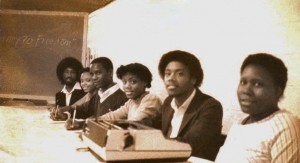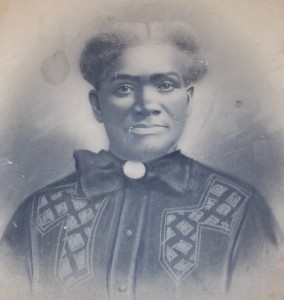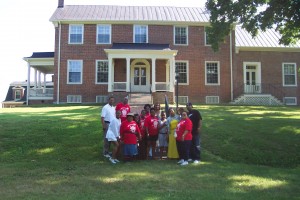On August 13th the Terry family will celebrate their bi-annual family reunion in Springfield, Tennessee. The reunion festivities will include a tour of Wessyngton Plantation. Hundreds of descendants across the country will attend the reunion. The Terry family is one of the largest families from Wessyngton with over 1,000 descendants, spanning eleven generations from their first ancestors, Dick Terry and Aggie Washington Terry.
Archive for the ‘Plantation Life’ Category
Terry Family to Celebrate Family Reunion
Tuesday, July 26th, 201130 Year Old Photo Foretells Subtitle of The Washingtons of Wessyngton Plantation
Tuesday, July 26th, 2011Recently while going through some old photographs, I ran across this one taken with childhood friends Wanda Gardner, Drextel Bowling, Teresa Gardner, Charles Gardner and Kim Bradley. The photo was taken in 1981 at Greater South Baptist Church during a Black history lesson. I was quite surprised when I noticed the blackboard behind me had part of the subtitle to my book Journey to Freedom in the background nearly thirty years before the book was published. My publishers at Atria Books, a Division of Simon & Schuster selected the subtitle for The Washingtons of Wessyngton Plantation.
Washington Hall Mansion Before its Fiery End
Monday, May 23rd, 2011On May 3rd, I had the honor of giving a presentation on The Washingtons of Wessyngton Plantation to the Austin Peay Women’s Book Club in Clarksville, Tennessee. To my surprise, one of the book club members presented me with a photo of Washington Hall taken in 1965 a few months before it burned.
George Augustine Washington Jr. and his wife Marina “Queenie” Woods, began construction on the magnificent home in 1896. Washington Hall was a three-story white brick mansion with forty-four rooms. In its heyday Washington Hall was one of the showplaces in the South, where some of the crowned heads of Europe had been entertained.
In 1965 the Washington Hall mansion burned to the ground. The grand entrance gate is the only remnant of its former glory.
Digitalization of Southampton County Virginia Records Opens New Doors for African American Research
Sunday, April 17th, 2011The entire Court Order book collection of the Southampton County, Virginia Court from 1749 through the early 1880s has been digitalized. This includes 57,000 pages, involving approximately one million names. This information is free online at: www.wiki.familysearch.org/en/Southampton_County,_Virginia. This collection is a goldmine for African Americans tracing their ancestors who once lived in Southampton County. Many of the books that have been digitized were 300 to 700 pages. Court Order books from the 1700s to the end of the slave trade lists the names of Africans when they were first brought to the area, their ages, owner’s names, and in a few cases the ships on which they were brought over. Wills and estate settlements lists the names of slaves, descriptions and family relationships. If your ancestors came from Southampton County, Virginia, you must check out this collection. Thanks go to Southampton Circuit Court Clerk, Richard Francis, and the volunteers of the Brantley Association of America who undertook this huge project in 2009 and 2010.
Portraits of Gardner Ancestors Revealed at 76th Gardner Family Reunion
Monday, April 11th, 2011
In August 2010 the Gardner family celebrated their 76th annual family reunion. The festivities included a tour of Wessyngton Plantation. Aaron Gardner born 1804, his wife Betty born 1814, and their three sons Daniel Gardner 1829-1911, George Gardner 1830-1906, and Jackson Gardner Washington born 1831 were enslaved on the plantation from 1839 to 1865. After emancipation George Gardner purchased 169 acres of land, which he willed to his nephew Will Gardner. Daniel Gardner and his wife Melissa Boisseau Gardner were the parents of eighteen children. Many of their descendants remain in the Robertson County area. There are more African Americans carrying the Gardner surname than any other surname in the county. Two original portraits of Daniel and Melissa Gardner were revealed to descendants at the 76th Gardner family reunion.
Washington Surname Most Common among African Americans in America—and in Robertson County, Tennessee
Wednesday, March 2nd, 2011According to an interesting article by Jesse Washington of the Associated Press entitled “Washington Named the ‘Blackest Name’ in America,”
Based on the 2000 U. S. census, Washington is the most prominent surname among African Americans. 90% of 163,036 individuals with the Washington surname are African Americans, a far greater percentage than any other name.
The descendants of African Americans once enslaved on Wessyngton Plantation are part of this group. Before and after Emancipation, they chose to use the Washington surname—the surname of the slaveholding Washington family (were distant cousins of the president).
At the onset of the Civil War there were nearly 300 African Americans on Wessyngton Plantation. In 1870, 212 former slaves and their descendants from Wessyngton in Robertson County carried the Washington surname. This was nearly 5% of the total number of African Americans in the county.
In the years following the Civil War hundreds of Washingtons from Robertson County migrated out of the area. Today there are still African Americans in the area who carry the Washington surname (although far fewer than decades earlier), and some African American Washingtons throughout the country are descended from the Wessyngton Washingtons.
Runaway Slave Escapes to Freedom in Canada
Wednesday, January 19th, 2011Elijah Smyth or Smith was originally owned by Joseph L. D. Smith on his plantation in Florence, Alabama. When Joseph Smith died in 1837, Elijah was inherited by Smith’s minor daughter Jane, who later married George Augustine Washington of Wessyngton Plantation.
Between 1850 and 1860, Elijah Smyth made his escape from slavery in Alabama most likely using the Underground Railroad. He made it to freedom in Buxton, Canada. Buxton, was established in 1849 by the abolitionist Reverend William King, and was one of four settlements in Canada which offered refuge for fugitive slaves. Buxton was located between Lake Erie and the Great Western railway, and consisted of approximately 9,000 acres of land. The logging industry provided an income for most of its residents.
Reverend King had strict guidelines for the settlers: land could not be leased, and could only be purchased by African Americans for $2.50 per acres. Once the land was purchased it had to be held for ten years. Houses had to be built that were at least 24 x 18 x 12 feet with a porch, and picket fence and flower garden in front. The town had four churches, three schools, a hotel and its own post office. In 1860, Buxton’s population was its largest with about 700 residents.
Elijah Smyth was literate. Since educating slaves was forbidden by law in Alabama, he probably was educated at the Buxton school.
Between 1850 and 1860, Elijah Smyth wrote a letter to Jane Smith’s aunt, Anne Pope. He sent the letter from Buxton, Canada.
Mrs. Pope,
Will you be so kind as I do not know who my young Mrs. is married to or where she lives. The least she will take for my papers of liberty as I am ready to pay a reasonable price. It is better for her to get a half loaf than no bread. If she will take a reasonable price write to me and then I will write to you and let you know what day to have a man in Detroit with my papers and will send the money by a friend to meet him. Be so kind as to write to me in haste.
No more but kindness,
Yours truly Elijah Smyth
[Washington Family Papers]
In the letter Elijah Smyth offered to purchase his freedom. It is unknown why he made the offer since he was already free. He might have wanted to purchase the freedom of other family members who were still enslaved. It also is not known whether Jane Smith responded to his letter or accepted his offer.
Washington Descendants Visit Wessyngton Plantation During Family Reunion
Friday, June 25th, 2010On June 19th members of the Washington family visited Wessyngton Plantation as part of their family reunion. The tour included a visit to the mansion, Washington family cemetery, and a restored slave cabin. Family members descend from Temperance Washington born 1795, who was enslaved on the plantation along with her son Sam and daughter Jane in 1815. Sam Washington born 1812 married Jane Hadley 1835-1916. After emancipation the Washington family remained in the Cedar Hill, Tennessee area. Members of the family were instrumental in establishing the St. James Baptist Church in Cedar Hill. On June 20th the church celebrated its anniversary where numerous Washington descendants still worship. These members descend from Sam and Jane’s children: Nelson Washington, Irvin Washington, Temperance Washington Sherrod, and Betty Washington Smothers.
National Black Arts Festival Study Group Walks in Footsteps of Baker’s Ancestors on Wessyngton Plantation
Sunday, June 13th, 2010
In addition to touring the grounds surrounding the Wessyngton mansion, National Black Arts Festival members and guests walked in the footsteps of Baker’s ancestor in the slave cabin area of the plantation. The group went inside a restored slave cabin built ca. 1830. In 1860, there were 274 enslaved African Americans on the plantation, housed in forty log cabins. At the onset of the Civil War, Wessyngton held the largest African American population in the state of Tennessee and was the largest tobacco producer in America.
National Black Arts Study Group at Wessyngton Plantation
Sunday, June 13th, 2010Today I had the honor of conducting a study group tour of Wessyngton Plantation for Dr. Collette Hopkins, Director of the National Black Arts Festival of Atlanta, along with a number of her colleagues and distinguished guest. The tour included a visit to the Wessyngton mansion, Washington family cemetery, and a former slave cabin. Participants were told about the lives of enslaved African Americans on the largest tobacco plantation in America and walked in their footsteps.
The above photo was taken at the entrance gate to Wessyngton Plantation where I was told as a small child by my grandfather that was where my ancestors came from. The interest in my family’s history led me on a thirty year journey of discovery and the writing of The Washingtons of Wessyngton Plantation: Stories of My Family’s Journey to Freedom.





